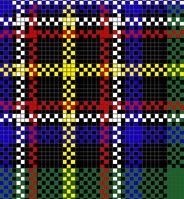
Besides looking great, plaids are often colorful and easy to stitch. That’s why stitching one can make fantastic needlepoint.
All too often though, we feel constrained. It can be one, or more of several things:
- We can’t find a shape we like and that is the right size.
- We can’t find a colorful plaid.
- We don’t know what part of the plaid to pick.
Today we’ll talk about these problems and tomorrow’s article will give you step-by-step instructions for making these projects.
Shapes
Any shape that is mostly free of detail inside the outline and that has a relatively smooth outline is perfect for needlepoint. You want a smooth outline because it is much easier to stitch. Narrower areas should be avoided because less of the plaid will show.
Interior details that convey information in a picture will often just interrupt the plaid too much to have the pattern make sense. For example if the Scottie dog above had eyes, that would be OK because they would be large. If it had a mouth, eyes, whiskers and details of hair, that picture would not be a good outline for a plaid.
Although few would make plaid flowers, the two pictures below give you an idea of what I mean. The top design, a simple five-petalled flower, is perfect for use as an outline for needlepoint. The bottom picture, a rose, has far too much interior detail to be used for this purpose (although it might make lovely needlepoint).

If you are searching on the Internet, look for templates, die-cuts, cookie cutters, or outlines. Coloring book designs for kids can often work as well. Stencils, if not multi-colored or too detail are another possibility.
Your template may not be the size you want. If this is the case, print it out and use your copier or a copy center to reduce or enlarge it to the right size.
Plaids

There are literally hundreds of registered tartans and they come in just about any color combination you can think of. My favorite source for tartans is the Tartan Registry. It includes all registered tartans and you can see great flat pictures of them. From there you can generate a chart for the plaid.
The picture above is a chart I made from a registered tartan. I have many already charted tartans or will do custom tartans and personal plaids. Visit my needlepoint plaids site for more information.
You can also use names or dates to generate a personal plaid. Because these are original to you you can make them any colors you like. The picture below of personal plaid frame weights from The Needle Works in Austin gives you an idea of the variety.

Patterns

A big concern whenever you are putting something patterned into a shape is finding the part of the pattern that will look interesting. If your plaid has large areas of solid color, those might not be the best choice for your template.
Look for areas where the stripes are narrow and the color changes often. The picture above shows the IrishNational tartan as the full repeat. The picture below shows the area selected for a small Christmas light ornament.

Section of Irish National tartan for template, copyright Napa Needlepoint
Depending on your shape, you can center your plaid pattern or put it off to the side. I’ve seen both.
Come back tomorrow for instructions on making these ornaments, including a free template.
About Janet M Perry
Janet Perry is the Internet's leading authority on needlepoint. She designs, teaches and writes, getting raves from her fans for her innovative techniques, extensive knowledge and generous teaching style. A leading writer of stitch guides, she blogs here and lives on an island in the northeast corner of the SF Bay with her family


Leave a Reply